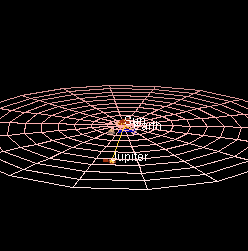@zqbinggong
2016-05-17T03:38:42.000000Z
字数 3660
阅读 1609
the solar system
homework of Computational Physics ch4
张强 2013301020039
Code
Abstract
Wr begin with the simplest system, a sun and a single planet, and investigate a few of properties of this model solar system.While a computational approach is not required in this case, the algrothm we develop will prove useful for later problems.Additionally,comparisons of teh numercial results ovtained with this algrothm with exact solutions will provide valuable insight into the nature of our approximation.
Key word
solar system,double star,inverse-square law
Background


The exerxise 3.29ask us to explore the intermittency route to chaos for in more details.
Body
1Overview
The Solar System is the gravitationally bound system comprising the Sun and the objects that orbit it, either directly or indirectly. Of those objects that orbit the Sun directly, the largest eight are the planets,with the remainder being significantly smaller objects, such as dwarf planets and small Solar System bodies. Of the objects that orbit the Sun indirectly, the moons, two are larger than the smallest planet, Mercury.
The Solar System formed 4.6 billion years ago from the gravitational collapse of a giant interstellar molecular cloud. The vast majority of the system's mass is in the Sun, with most of the remaining mass contained in Jupiter. The four smaller inner planets, Mercury, Venus, Earth and Mars, are terrestrial planets, being primarily composed of rock and metal. The four outer planets are giant planets, being substantially more massive than the terrestrials. The two largest, Jupiter and Saturn, are gas giants, being composed mainly of hydrogen and helium; the two outermost planets, Uranus and Neptune, are ice giants, being composed mostly of substances with relatively high melting points compared with hydrogen and helium, called ices, such as water, ammonia and methane. All planets have almost circular orbits that lie within a nearly flat disc called the ecliptic.
The Solar System also contains smaller objects. The asteroid belt, which lies between the orbits of Mars and Jupiter, mostly contains objects composed, like the terrestrial planets, of rock and metal. Beyond Neptune's orbit lie the Kuiper belt and scattered disc, which are populations of trans-Neptunian objects composed mostly of ices, and beyond them a newly discovered population of sednoids. Within these populations are several dozen to possibly tens of thousands of objects large enough that they have been rounded by their own gravity. Such objects are categorized as dwarf planets. Identified dwarf planets include the asteroid Ceres and the trans-Neptunian objects Pluto and Eris.In addition to these two regions, various other small-body populations, including comets, centaurs and interplanetary dust, freely travel between regions. Six of the planets, at least four of the dwarf planets, and many of the smaller bodies are orbited by natural satellites,usually termed "moons" after the Moon. Each of the outer planets is encircled by planetary rings of dust and other small objects.
The solar wind, a stream of charged particles flowing outwards from the Sun, creates a bubble-like region in the interstellar medium known as the heliosphere. The heliopause is the point at which pressure from the solar wind is equal to the opposing pressure of interstellar wind; it extends out to the edge of the scattered disc. The Oort cloud, which is thought to be the source for long-period comets, may also exist at a distance roughly a thousand times further than the heliosphere. The Solar System is located in the Orion Arm, 26,000 light-years from the center of the Milky Way.
2.the Newton's law of gravitation is
Results(figure)
1.bianry star system,for

2.use Vpython to show the trajectory of the bianry star system
For different value of and differen initail speed, we can get different orbit of the bianry star system.And means the initail speed of the two body is same






in the last figure, if you are patient, you will find the something amazing.

3.

Conclusion
For different value of and differen initail speed, we can get different orbit of the bianry star system
Acknowledgement
Thanks to Chen yangyao for his template.
Thanks to Liu WWentao for his template.
